-
January
-
February
- This Week in History: February 6-12 – Lesson
- This Week in History: February 6-12 – Quiz
- This Week in History: February 13-19 – Lesson
- This Week in History: February 13-19 – Quiz
- This Week in History: February 20-26 – Lesson
- This Week in History: February 20-26 – Quiz
- This Week in History: February 27-March 5 – Lesson
- This Week in History: February 27-March 5 – Quiz
-
March
- This Week in History: March 6-12 – Lesson
- This Week in History: March 6-12 – Quiz
- This Week in History: March 13-19 – Lesson
- This Week in History: March 13-19 – Quiz
- This Week in History: March 20-26 – Lesson
- This Week in History: March 20-26 – Quiz
- This Week in History: March 27-April 2 – Lesson
- This Week in History: March 27-April 2 – Quiz
-
April
- This Week in History April 3-9 – Lesson
- This Week in History April 3-9 – Quiz
- This Week in History: April 10-16 – Lesson
- This Week in History: April 10-16 – Quiz
- This Week in History: April 17-23 – Lesson
- This Week in History: April 17-23 – Quiz
- This Week in History: April 24-30 – Lesson
- This Week in History: April 24-30 – Quiz
-
May
- This Week in History: May 1 – 7 – Lesson
- This Week in History: May 1 – 7 – Quiz
- This Week in History: May 8 – 14 – Lesson
- This Week in History: May 8 – 14 – Quiz
- This Week in History: May 15 – 21 – Lesson
- This Week in History: May 15 – 21 – Quiz
- This Week in History: May 22-28 – Lesson
- This Week in History: May 22-28 – Quiz
- This Week in History: May 29-June 4 – Lesson
- This Week in History: May 29-June 4 – Quiz
-
June
- This Week in History: June 5 – 11 – Lesson
- This Week in History: June 5 – 11 – Quiz
- This Week in History: June 12-18 – Lesson
- This Week in History: June 12-18 – Quiz
- This Week in History: June 19-25 – Lesson
- This Week in History: June 19-25 – Quiz
- This Week in History: June 26 – July 2 – Lesson
- This Week in History: June 26 – July 2 – Quiz
-
July
- This Week in History: July 3 – 9 – Lesson
- This Week in History: July 3 – 9 – Quiz
- This Week in History: July 10 – 16 – Lesson
- This Week in History: July 10 – 16 – Quiz
- This Week in History July 17 – 23 – Lesson
- This Week in History July 17 – 23 – Quiz
- This Week in History – July 24-30 – Lesson
- This Week in History – July 24-30 – Quiz
- This Week in History: July 31 – August 6 – Lesson
- This Week in History: July 31 – August 6 – Quiz
-
August
- This Week in History: August 7-13 – Lesson
- This Week in History: August 7-13 – Quiz
- This Week in History: August 14 – 20 – Lesson
- This Week in History: August 14 – 20 – Quiz
- This Week in History: August 21 – 27 – Lesson
- This Week in History: August 21 – 27 – Quiz
- This Week in History: August 28 – September 3 – Lesson
- This Week in History: August 28 – September 3 – Quiz
-
September
- This Week in History: September 4 – 10 – Lesson
- This Week in History: September 4 – 10 – Quiz
- This Week in History: September 11 -17 – Lesson
- This Week in History: September 11 -17 – Quiz
- This Week in History: September 18 – 24 – Lesson
- This Week in History: September 18 – 24 – Quiz
- This Week in History: September 25 – October 1 – Lesson
- This Week in History: September 25 – October 1 – Quiz
-
October
- This Week in History: October 2-8 – Lesson
- This Week in History: October 2-8 – Quiz
- This Week in History: October 9 –15 – Lesson
- This Week in History: October 9 –15 – Quiz
- This Week in History: October 16–22 – Lesson
- This Week in History: October 16–22 – Quiz
- This Week in History: October 23–29 – Lesson
- This Week in History: October 23 –29 – Quiz
- This Week in History: October 30 – November 5 – Lesson
- This Week in History: October 30 – November 5 – Quiz
-
November
- This Week in History: November 6 – 12 – Lesson
- This Week in History: November 6 – 12 – Quiz
- This Week in History: November 13 – 19 – Lesson
- This Week in History: November 13 – 19 – Quiz
- This Week in History: November 20 – 26 – Lesson
- This Week in History: November 20 – 26 – Quiz
- This Week in History: November 27- December 3 – Lesson
- This Week in History: November 27- December 3 – Quiz
-
December
This Week in History: August 7-13 – Lesson
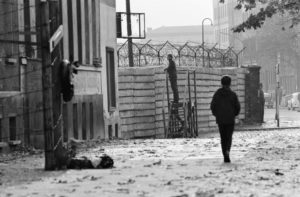
Scenes in Berlin, three years after work began on the construction of the Berlin Wall, separating East from West. (Photo by Abthorp/Mirrorpix/Getty Images)
“Today is either the beginning of the end, or the end of the beginning. Today we are making history.” ~ Eckhard Pfeiffer
August 13, 1961: Building the Berlin Wall
After World War II ended in 1945, Germany was split into four “allied occupation zones.” The Allies (Britain, France, the Soviet Union, and the United States) had defeated the Axis Powers (Germany, Italy, and Japan), and they decided to divide Germany so that each Ally got a part of the country. However, disagreements soon began as the communist Soviet Union competed for power over Europe with the capitalist countries of Britain, the US, and France (the Western Allies).
The Soviet Union received the eastern part of Germany while the western section went to the US, Great Britain, and, later, to France as well. The city of Berlin was inside the Soviet’s section, but the post-war agreement also split the city into halves where the the Soviets had the eastern portion, and the Western Allies controlled the western half. Soviet leader Nikita Khrushchev did not like the idea of a West Berlin inside a communist East Germany, saying it “stuck like a bone in the Soviet throat.” The Russians started trying to drive out the Western Allies. They tried building a blockade, but the Western Allies, in what is known as the Berlin Airlift, delivered food and supplies by air. This lasted for a year and ended in 1949.
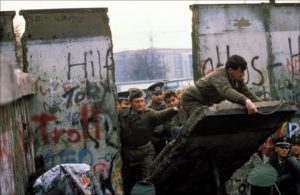
(Photo by Patrick PIEL/Gamma-Rapho via Getty Images)
In 1958, the Soviets were upset by the number of refugees fleeing their area. Most of these were young and skilled people such as doctors and teachers. Nearly three million had left East Germany since the blockade. And the trend continued with more and more people leaving.
On August 13, 1961, Khrushchev gave the East German government the go-ahead to close the border for good, to prevent people from leaving. At first, this was done with barbed wire. Later, a huge concrete wall was built. It was 12 feet tall and 103 miles long.
Imagine your city being split in half, and to go to the other side, you’d have to go through various checkpoints – if you could leave your territory at all. This is how it was for the citizens, who had been used to being able to take trains and subways to different parts of the city. Most citizens of East and West Berlin were not allowed to cross the border. More than 171 people died attempting to sneak over the wall.
In 1989, the East German government finally opened the wall, and by 1990, it was torn down. A year later, the Soviet Union collapsed, ending the era of communism in Eastern Europe.
Other Notable History Mentions
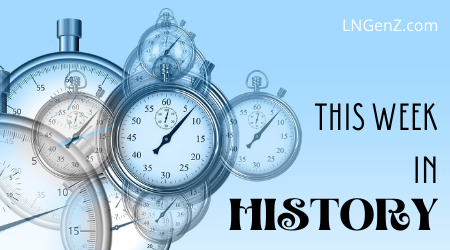 August 7, 1964: Congress approved the Gulf of Tonkin Resolution after an attack on two US destroyers off the Gulf of Tonkin, North Vietnam. It gave President Lyndon B. Johnson the power to “take all necessary measures to repel any armed attack against the forces of the United States and to prevent further aggression.”
August 7, 1964: Congress approved the Gulf of Tonkin Resolution after an attack on two US destroyers off the Gulf of Tonkin, North Vietnam. It gave President Lyndon B. Johnson the power to “take all necessary measures to repel any armed attack against the forces of the United States and to prevent further aggression.”
August 7, 1990: President George Bush ordered Desert Shield, the first phase of the Gulf War against Iraq, which had invaded its neighbor Kuwait.
August 8, 1945: Soviet Russia sent troops to Manchuria, which was held by the Japanese, and declared war on Japan.
August 9, 1974: President Richard Nixon officially resigned as a result of the Watergate scandal. He is the first and only president to resign.
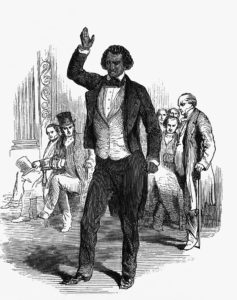
Frederick Douglass addressing an English audience during his visit to London in 1846. (Getty Images)
August 11, 1841: Frederick Douglass, an escaped slave, spoke for the first time in front of an audience in the North.
August 12, 1676: Metacom, leader of the Pokanoket tribe, was assassinated, ending King Philip’s War. Metacom, who the colonists had nicknamed King Philip, had led an uprising against the white settlers that lasted almost two years.
Famous Birthdays
Mata Hari (August 7, 1876) was born in Leeuwarden, Netherlands. She was an international spy who was arrested in 1917 by the French as a German Spy. At her execution, she threw a kiss to the firing squad.
Ralph J. Bunche (August 7, 1876) was born in Detroit, Michigan. He was a black statesman and Nobel Prize winner. In 1949, he was a mediator for the UN and helped end hostilities between the Arab League and Israel.
Matthew Henson (August 8, 1866) was born in Charles County, Maryland. He went on Artic expeditions with Robert E. Peary, including traveling to the North Pole on April 6, 1909.
Herbert Hoover (August 10, 1874) was born in West Branch, Iowa. He was the 31st president.
Cecil B. DeMille (August 12, 1881) was born in Ashfield, Massachusetts. A film producer, he is known for such famous works as The Ten Commandments, The Greatest Show on Earth, and Cleopatra.
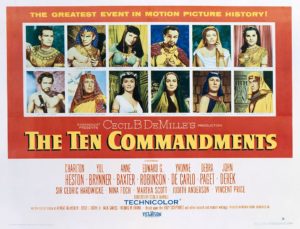
(Photo by Movie Poster Image Art/Getty Images)
Lucy Stone (August 13, 1818) was born near West Brookfield, Massachusetts. She was an advocate for women’s rights and abolishing slavery, and she helped to found the American Suffrage Association.
Annie Oakley (August 13, 1818) was born in Darke County, Ohio. She was a famous Wild West performer, well-known for her shooting skills. She was part of Buffalo Bill’s Wild West Show for 17 years.
Alfred Hitchcock (August 13, 1899) was born in London, England. A British film director, some of his most known films include Psycho and The Birds, as well as his hit TV series Alfred Hitchcock Presents.
Fidel Castro (August 13, 1927) was born in Mayari, Oriente Province, Cuba. He started a rebellion that drove out Fulgencio Batista, then became a dictator of Cuba himself.